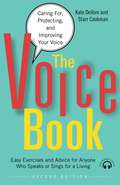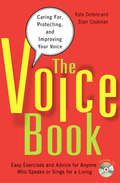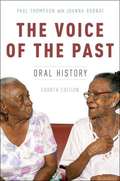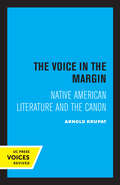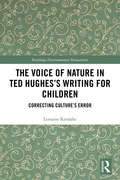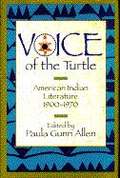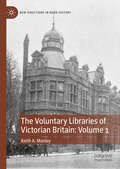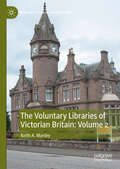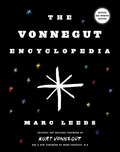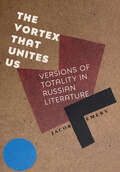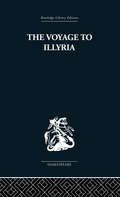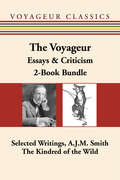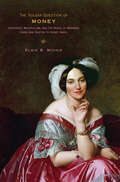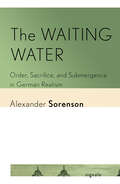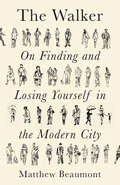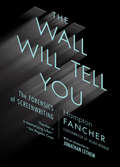- Table View
- List View
The Voice Book: Caring For, Protecting, and Improving Your Voice
by Starr Cookman Kate DeVoreMore than 30 million Americans rely on their voices for their jobs—from teachers, religious leaders, and entertainers to lawyers, executives, salespeople, and doctors. A controlled voice increases self-confidence and enhances charisma, approachability, and trustworthiness. Yet an astounding 30 percent of professionals develop preventable vocal problems that could ruin their careers. And most do not know that both the quality and tone of one's voice can be changed.The Voice Book: Caring For, Protecting, and Improving Your Voice is a one-of-a-kind reference that will save and improve your voice, your job, and your personal life. With dozens of vocal exercises and a detailed guide to the anatomy and physiology of voice, the book covers the full range of vocal health, from protecting against hoarseness and laryngitis to expanding speaking range and enhancing voice tone and quality. Illustrations, photographs, FAQs, and downloadable audio tracks make this updated edition of The Voice Book a must-read for anyone who wants a dependable, strong, and engaging voice.
The Voice Book: Caring For, Protecting, and Improving Your Voice
by Kate Devore Starr CookmanWritten to save careers one voice at a time through scientifically proven methods and advice, this resource teaches people how to protect and improve one of their most valuable assets: their speaking voice. Simple explanations of vocal anatomy and up-to-date instruction for vocal injury prevention are accompanied by illustrations, photographs, and FAQs. An audio CD of easy-to-follow vocal-strengthening exercises--including Hum and Chew, Puppy Dog Whimper, Sirens, Lip Trills, and Tongue Twisters--is also included, along with information on breathing basics, vocal-cord vibration, and working with students who have medical complications such as asthma, acid reflux, or anxiety.
The Voice Of The Past: Oral History
by Paul Thompson Joanna BornatThe Voice of the Past: Oral History
The Voice in the Margin: Native American Literature and the Canon
by Arnold KrupatIn its consideration of American Indian literature as a rich and exciting body of work, The Voice in the Margin invites us to broaden our notion of what a truly inclusive American literature might be, and of how it might be placed in relation to an international—a "cosmopolitan"—literary canon. The book comes at a time when the most influential national media have focused attention on the subject of the literary canon. They have made it an issue not merely of academic but of general public concern, expressing strong opinions on the subject of what the American student should or should not read as essential or core texts. Is the literary canon simply a given of tradition and history, or is it, and must it be, constantly under construction? The question remains hotly contested to the present moment. Arnold Krupat argues that the literary expression of the indigenous peoples of the United States has claims on us to more than marginal attention. Demonstrating a firm grasp of both literary history and contemporary critical theory, he situates Indian literature, traditional and modern, in a variety of contexts and categories. His extensive knowledge of the history and current theory of ethnography recommends the book to anthropologists and folklorists as well as to students and teachers of literature, both canonical and noncanonical. The materials covered, the perspectives considered, and the learning displayed all make The Voice in the Margin a major contribution to the exciting field of contemporary cultural studies. This title is part of UC Press's Voices Revived program, which commemorates University of California Press’s mission to seek out and cultivate the brightest minds and give them voice, reach, and impact. Drawing on a backlist dating to 1893, Voices Revived makes high-quality, peer-reviewed scholarship accessible once again using print-on-demand technology. This title was originally published in 1989.
The Voice of Nature in Ted Hughes’s Writing for Children: Correcting Culture's Error (Routledge Environmental Humanities)
by Lorraine KerslakeDespite the fame Ted Hughes’s poetry has achieved, there has been surprisingly little critical writing on his children’s literature. This book identifies the importance of Hughes’s children’s writing from an ecocritical perspective and argues that the healing function that Hughes ascribes to nature in his children’s literature is closely linked to the development of his own sense of environmental responsibility. This book will be the first sustained examination of Hughes’s greening in relation to his writing for children, providing a detailed reading of Hughes’s children’s literature through his poetry, prose and drama as well as his critical essays and letters. In addition, it also explores how Hughes’s children’s writing is a window to the poet’s own emotional struggles, as well as his environmental consciousness and concern to reconnect a society that has become alienated from nature. This book will be of great interest to not only those studying Ted Hughes, but also students and scholars of environment and literature, ecocriticism, children’s literature and twentieth-century literature.
The Voice of the Turtle: American Indian Literature 1900-1970
by Paula Gunn AllenStories from a variety of native American authors 1900-1970
The Voice: 40 years of Black British Lives
by The VoiceLaunched at the 1982 Notting Hill Carnival, The Voice newspaper captured and addressed a generation figuring out what it meant to be Black and British. Written for and by Black people, the newspaper shone a light on systematic injustices as well as celebrating Black Britain's success stories. From hard hitting news reports covering the murder of Stephen Lawrence to championing the likes of Sir Lewis Hamilton and Idris Elba, the newspaper has campaigned, celebrated and educated people for the last forty years.As well as celebrating amazing successes in sport, politics and the arts, The Voice documented everyday life in the community, from the emergence of a Black middle class in the '90s and the achievements of Black entrepreneurs to how different facets of the community were explored in contemporary music and literature. Since its small beginnings in Hackney, The Voice has also become a fantastic training ground for prominent journalists and figures including former politician Trevor Phillips, broadcaster Rageh Omaar and writer Afua Hirsch. Today, The Voice is Britain's longest running and only Black newspaper.Told through news reports, editorials and readers' personal letters, this emotive book documents the social history of Black Britain over the last four decades. Each chapter is illustrated with amazing newspaper pages from The Voice's extensive archives as well as iconic and dramatic front covers from 1982 to the present day.With a foreword from Sir Lenny Henry and written by former and current Voice journalists, this powerful book is a celebration of the ground-breaking paper which gave a voice to the voiceless.
The Voluble Soul: Thomas Traherne's Poetic Style and Thought
by Richard Willmott"The world's fair beauty set my soul on fire." In this first study of the full range of Traherne's poetry Richard Willmott explains his 'metaphysical' poetry to all who are attracted by the beauty of his language, but puzzled by his meaning. He offers guidance both for the student of English, uncertain about Traherne's theological ideas, and the student of theology, put off by seventeenth-century poetic conventions and diction. Using a wealth of quotation, he examines Traherne's verse alongside that of a variety of his contemporaries, including Andrew Marvell, Lucy Hutchinson, Anne Bradstreet and Edward Taylor. Central to Traherne's poetry and generous theology is his delight in the capacity of his soul to approach God through an appreciation of His infinite creation. This soul is 'voluble', not only because it can express its thoughts with fluency, but also because it can enfold within itself the infinity of God's creation, taking in everything that it perceives, considering the latest scientific speculations about the atom and astronomy, but also looking clear-sightedly at Restoration society's materialism and - in one startlingly savage satire - the corruption of the royal court.
The Voluntary Libraries of Victorian Britain: Volume 1 (New Directions in Book History)
by Keith A. ManleyThis volume provides an examination of the kind of free (or nearly free) libraries which were available to the general public in England and Wales in the late nineteenth century, but which were not supported by local taxation. They were effectually substitutes for municipal public libraries in areas where that sort of library provision did not exist. And they were voluntary because they did not enjoy funding from local councils but from wealthy philanthropists or from raising money themselves from well-wishers. Many of those libraries were located in cities and towns (there were many in London) but village libraries are included. Volume 2 covers Scotland and Ireland, as well as the often-ignored subject of workplace libraries.
The Voluntary Libraries of Victorian Britain: Volume 2 (New Directions in Book History)
by Keith A. ManleyThis volume provides an examination of the kind of free (or nearly free) libraries which were available to the general public in Scotland and Wales in the late nineteenth century, but which were not supported by local taxation. They were effectually substitutes for municipal public libraries in areas where that sort of library provision did not exist. They may have been funded by wealthy philanthropists or by well-wishers. Attention is paid too to libraries which were aimed at specific communities, such as workers in factories, mills, mines, railway works, and shops, as well as book provision for policemen, soldiers and sailors, hospital patients, nurses, workhouses, prisoners, and domestic servants (and hotel guests). The voluntary public libraries of England and Wales are dealt with in Volume 1.
The Vonnegut Encyclopedia: Revised and updated edition
by Mark Vonnegut Kurt Vonnegut Marc LeedsNow expanded and updated, this authorized compendium to Kurt Vonnegut's novels, stories, essays, and plays is the most comprehensive and definitive edition to date. Over the course of five decades, Kurt Vonnegut created a complex and interconnected web of characters, settings, and concepts. The Vonnegut Encyclopedia is an exhaustive guide to this beloved author's world, organized in a handy A-to-Z format. The first edition of this book covered Vonnegut's work through 1991. This new and updated edition encompasses his writing through his death in 2007. Marc Leeds, co-founder and founding president of the Kurt Vonnegut Society and a longtime personal friend of the author's, has devoted more than twenty-five years of his life to cataloging the Vonnegut cosmos--from the birthplace of Kilgore Trout (Vonnegut's sci-fi writing alter ego) to the municipal landmarks of Midland City (the midwestern metropolis that is the setting for Vonnegut's 1973 masterpiece Breakfast of Champions). The Vonnegut Encyclopedia identifies every major and minor Vonnegut character from Celia Aamons to Zog, as well as recurring images and relevant themes from all of Vonnegut's works, including lesser-known gems like his revisionist libretto for Stravinsky's opera L'Histoire du soldat and his 1980 children's book Sun Moon Star. Leeds provides expert notes explaining the significance of many items, but relies primarily on extended quotations from Vonnegut himself. A work of impressive scholarship in an eminently browsable package, this encyclopedia reveals countless connections readers may never have thought of on their own. A rarity among authors of serious fiction, Kurt Vonnegut has always inspired something like obsession in his most dedicated fans. The Vonnegut Encyclopedia is an invaluable resource for readers wishing to revisit his fictional universe--and those about to explore it for the first time.From the Hardcover edition.
The Vortex That Unites Us: Versions of Totality in Russian Literature (NIU Series in Slavic, East European, and Eurasian Studies)
by Jacob EmeryThe Vortex That Unites Us is a study of totality in Russian literature, from the foundation of the modern Russian state to the present day. Considering a diversity of texts that have in common chiefly their prominence in the Russian literary canon, Jacob Emery examines the persistent ambition in Russian literature to gather the whole world into an artwork. Emery reveals how the diversity of totalizing figures in the Russian canon—often in alliance with ideologies like the totalitarian state or enlightenment reason—strive for the frontiers of space and time in order to guarantee the coherence of the globe and the continuity of history. He expores subjects like romantic metaphors of supernatural possession; Tolstoy's conception of art as a vector of emotional contagion; the panoramic ambitions of the avant-garde to grasp the globe in a new poetic medium; efforts of Soviet utopians to harmonize the whole of social life along aesthetic lines; Mandelstam's evocation of writing as a transcendental authority that guarantees a grandiose historical rhythm even when manifested as authoritarian repression; and the mass market of cultural commodities in which the exiled Vladimir Nabokov found success with his novel Lolita. The Vortex That Unites Us reveals a common thread in the disparate works it explores, bringing into a single horizon a variety of typically siloed texts and aesthetic approaches. In all these cases, the medium of totality is the body, inspired by artistic vision and compelled by aesthetic response.
The Voyage of Argo
by Apollonius RhodesWritten in the third century BC in Alexandria, this is the only full surviving account of Jason's legendary quest for the Golden Fleece. It describes the thrilling adventures of the Argonauts on their voyage to Colchis to plead with king Aeetes for the fleece, his greatest treasure - and the Eros-inspired passion felt by his daughter, the beautiful witch-princess Medea, for the scheming Jason. Chronicling a journey that sees Jason and his crew traverse perilous seas, negotiate the treacherous Cyanean Rocks, and confront the lure of the Sirens' song, The Voyage of Argo is a masterful depiction of distinctly human heroism and betrayal caused by love. An eloquent marriage of romance and realism, it tells the definitive version of one of the greatest legends of the classical age: an epic tale of bravery, prophecy and magic.
The Voyage to Illyria: A New Study of Shakespeare (Select Bibliographies Reprint Ser.)
by Kenneth MuirFirst published in 1937. This study argues that the plays of Shakespeare must be studied by comparison with each other and not as separate entities; that they must be related to one another, to the poems and to the Sonnets; that each individual play acquires a deeper significance from its setting in the corpus. Muir and O'Loughlin's critical analysis takes place against the personality of Shakespeare, asserting that that despite all their diversities a single mind and a single hand dominate them and that they are the outcome of one man's critical and emotional reactions to life.
The Voyageur Canadian Essays & Criticism 2-Book Bundle: Selected Writings, A.J.M. Smith / The Kindred of the Wild
by Michael Gnarowski Charles G. Roberts James Polk A.J.M. SmithVoyageur Classics is a series of new versions of Canadian classics, with added material and special introductions. In this bundle we find two classic works of the art of the Canadian essay. Charles G.D. Roberts was a distinguished writer of his time who published more than forty volumes of poetry, romance fiction, and nature writing – making him one of the most popular writers of his time. He pioneered the animal story in which he went beyond surface elements of nature and endowed his animal "characters" with qualities of feeling and intelligence that brought them closer to their human cousins. Roberts’ career as a writer transcended his Canadian roots and he was internationally known and popular in America and England. Arthur James Marshall Smith – prize-winning poet, essayist, influential anthologist, and critic – died in 1980. His last book, The Classic Shade: Selected Poems, on which Selected Writings is based, stands as his final intention in the world of literature. To this long out of print book the editor has added original material by Smith in which he defined and advanced modernism in Canadian writing. Includes Selected Writings, A.J.M. Smith The Kindred of the Wild
The Vulgar Question of Money: Heiresses, Materialism, and the Novel of Manners from Jane Austen to Henry James
by Elsie B. MichieIt is a familiar story line in nineteenth-century English novels: a hero must choose between money and love, between the wealthy, materialistic, status-conscious woman who could enhance his social position and the poorer, altruistic, independent-minded woman whom he loves. Elsie B. Michie explains what this common marriage plot reveals about changing reactions to money in British culture.It was in the novel that writers found space to articulate the anxieties surrounding money that developed along with the rise of capitalism in nineteenth-century England. Michie focuses in particular on the character of the wealthy heiress and how she, unlike her male counterpart, represents the tensions in British society between the desire for wealth and advancement and the fear that economic development would blur the traditional boundaries of social classes.Michie explores how novelists of the period captured with particular vividness England’s ambivalent emotional responses to its own financial successes and engaged questions identical to those raised by political economists and moral philosophers. Each chapter reads a novelist alongside a contemporary thinker, tracing the development of capitalism in Britain: Jane Austen and Adam Smith and the rise of commercial society, Frances Trollope and Thomas Robert Malthus and industrialism, Anthony Trollope and Walter Bagehot and the political influence of money, Margaret Oliphant and John Stuart Mill and professionalism and managerial capitalism, and Henry James and Georg Simmel and the shift of economic dominance from England to America.Even the great romantic novels of the nineteenth century cannot disentangle themselves from the vulgar question of money. Michie’s fresh reading of the marriage plot, and the choice between two women at its heart, shows it to be as much about politics and economics as it is about personal choice.
The Waiting Water: Order, Sacrifice, and Submergence in German Realism (Signale: Modern German Letters, Cultures, and Thought)
by Alexander SorensonThe Waiting Water addresses one of the most recurrent and troubling motifs in German Realist literature—death by drowning. Characters find themselves before bodies of water, presented with the familiar realm above the surface and the unobservable, uncanny domain beneath it. With somber regularity, they then disappear into the depths. Alexander Sorenson explores the role that these hidden deaths in water play within a literary movement that set out precisely to reveal universal truths about human life. The poetics of submergence, he argues, revolve around two concepts fundamental to Poetic Realism—order and sacrifice.Focusing on texts by Adalbert Stifter, Gottfried Keller, Marie von Ebner-Eschenbach, and Theodor Storm, along with material from earlier and later epochs, The Waiting Water shows that the pervasive symbolism of drowning scenes in German Realism, which typically occur in zones of narrative invisibility on the social periphery, reveals the extent to which realist narrative uses the natural environment to work through deeply embedded and hidden tensions that troubled the social and moral life of the age.
The Walker: On Losing and Finding Yourself in the Modern City
by Matthew BeaumontA literary history of walking From Dickens to ZizekThere is no such thing as the wrong step; every time we walk we are going somewhere. Moving around the modern city becomes more than from getting from A to B, but a way of understanding who and where you are. In a series of riveting intellectual rambles, Matthew Beaumont, retraces a history of the walker.From Charles Dicken's insomniac night rambles to wandering through the faceless, windswept monuments of the neoliberal city, the act of walking is one of escape, self-discovery, disappearances and potential revolution. Pacing stride for stride alongside such literary amblers and thinkers as Edgar Allen Poe, Andrew Breton, H G Wells, Virginia Woolf, Jean Rhys and Ray Bradbury, Matthew Beaumont explores the relationship between the metropolis and its pedestrian life. He asks can you get lost in a crowd? It is polite to stare at people walking past on the street? What differentiates the city of daylight and the nocturnal metropolis? What connects walking, philosophy and the big toe? Can we save the city - or ourselves - by taking the pavement?
The Wall Street Journal Guide to Business Style and Us
by Paul MartinHere at last is the indispensable resource that has helped the writers and editors of The Wall Street Journal earn a reputation for the most authoritative business writing anywhere. Originally written exclusively for the paper's staff, The Wall Street Journal Guide to Business Style and Usage is a landmark work. Many years in preparation, it has now been expanded and revised for anyone who wants to write well, but especially for those in the business community. The only book of its kind, it offers A-Z guidance on style and usage, bearing in mind the special needs of business professionals and including the latest business terminology. If ABC is no longer the American Broadcasting Company, what is it? What is the difference bet-ween "adjusted gross receipts" and "adjusted gross income"? How about the differences among "adopt," "approve," "enact" and "pass"? When should you say "affect" and when "effect"? When did Generation X end and Generation Y begin? And what the heck is the new name of Andersen Consulting? Our language is ever changing, ever mutating, and the choice of the right word bolsters your credibility with readers. As the go-to resource for these questions and others, The Wall Street Journal Guide to Business Style and Usage gives readers a competitive edge for succeeding in the world of business. It is an invaluable resource for any member of the business community who has ever had to write a memo, report, proposal, press release or e-mail. Destined to be the standard resource for years to come, The Wall Street Journal Guide to Business Style and Usage provides readers with access to the Journal Web site (www.wsjbooks.com), which will feature updates as new business terms enter the language or as old definitions or usages give way to new. This guide is the definitive reference work to keep close to your desk -- the last word for everyone who works with words.
The Wall Will Tell You: The Forensics of Screenwriting
by Hampton FancherA completely original guide to the screenwriter's art -- as only the writer of Blade Runner could concieve it.The master speaks, in this unique guide for screenwriters -- and writers and artists of all kinds. In short paragraphs--oracular and enigmatic, hardhitting and concrete--the man Forbes called a "creative genius" writes a guide book like none other for the aspiring screenwriter. Learn how to write living, breathing characters, exciting action and plot, and develop your own artistic vision. And learn how to never compromise that vision, most importantly, with yourself.
The Wand in the Word: Conversations with Writers of Fantasy
by Leonard S. MarcusIn a series of incisive interviews, Leonard S. Marcus engages thirteen master storytellers in spirited conversation about their life and work, providing inspiring reading for fantasy fans and future writers alike. What kind of child were you? When did you decide you wanted to be a writer? Why do you write fantasy? "Fantasy," writes Leonard S. Marcus, "is storytelling with the beguiling power to transform the impossible into the imaginable and to reveal our own 'real' world in a fresh and truth-bearing light." Few have harnessed this power with the artistry, verve, and imagination of the authors encountered in this compelling book. How do they work their magic? Finely nuanced and continually revealing, Leonard S. Marcus's interviews range widely over questions of literary craft and moral vision, as he asks thirteen noted fantasy authors about their pivotal life experiences, their literary influences and work routines, and their core beliefs about the place of fantasy in literature and in our lives.
The Wanderer: Elegies, Epics, Riddles (Legends from the Ancient North)
by Petra BornerPart of a new series Legends from the Ancient North, The Wanderer tells the classic tales that influenced JRR Tolkien's The Hobbit and The Lord of the Rings'So the company of men led a careless life,All was well with them: until One beganTo encompass evil, an enemy from hell.Grendel they called this cruel spirit...'J.R.R. Tolkien spent much of his life studying, translating and teaching the great epic stories of northern Europe, filled with heroes, dragons, trolls, dwarves and magic. He was hugely influential for his advocacy of Beowulf as a great work of literature and, even if he had never written The Hobbit and The Lord of the Rings, would be recognised today as a significant figure in the rediscovery of these extraordinary tales.Legends from the Ancient North brings together from Penguin Classics five of the key works behind Tolkien's fiction.They are startling, brutal, strange pieces of writing, with an elemental power brilliantly preserved in these translations.They plunge the reader into a world of treachery, quests, chivalry, trials of strength.They are the most ancient narratives that exist from northern Europe and bring us as near as we will ever get to the origins of the magical landscape of Middle-earth (Midgard) which Tolkien remade in the 20th century.
The Wandering Pine: Life as a Novel
by Per Olov EnquistWhen everything began so well, how could it turn out so badly? A blisteringly frank autobiographical novel by Sweden's great man of letters - for readers of K. O. Knausgaard's My Struggle."Some life. Some novel . . . Wonderful, brave, evocative . . . It is a remarkable story, and Enquist is remarkably frank in narrating every last detail" HeraldWhat was it about Hjoggböle, a farming village in the northernmost part of Sweden, that created so many idiots - and writers? There was nothing to indicate that P.O. Enquist would be stricken by an addiction to writing. Nothing in his family - honest, hardworking people. Not a trace of poetry. And yet he worked his way, via journalism, novels and plays, to the centre of Swedish politics and cultural life. His books garnered prize after prize. His plays ran for decades and premiered on Broadway. Why then, living with a new wife in Paris, does he hole up in their palatial Champes-Élysées apartment, talking only to his cat? How is it that he wakes to find himself in an uncoupled carriage on a railway siding in Hamburg, two - or was it three? - days after the first-night party finished? And what is it that drives him to run shoeless through the deep January snow of an Icelandic plain, leaving the lights of the drying out clinic far behind? Narrating in the third person, as if he were merely a character in the eventful, perplexing and ultimately triumphantly redemptive drama of his own life, P.O. Enquist is as elliptical as Karl Ove Knausgaard is exhaustive. Clear-eyed, rueful, written with elegance and humour, this is the singular story of a remarkable man.
The Wandering Signifier: Rhetoric of Jewishness in the Latin American Imaginary
by Erin Graff ZivinWhile Jews figure in the work of many modern Latin American writers, the questions of how and to what end they are represented have received remarkably little critical attention. Helping to correct this imbalance, Erin Graff Zivin traces the symbolic presence of Jews and Jewishness in late-nineteenth- through late-twentieth-century literary works from Argentina, Brazil, Peru, Mexico, Colombia, and Nicaragua. Ultimately, Graff Zivin's investigation of representations of Jewishness reveals a broader, more complex anxiety surrounding difference in modern Latin American culture. In her readings of Spanish American and Brazilian fiction, Graff Zivin highlights inventions of Jewishness in which the concept is constructed as a rhetorical device. She argues that Jewishness functions as a wandering signifier that while not wholly empty, can be infused with meaning based on the demands of the textual project in question. Just as Jews in Latin America possess distinct histories relative to their European and North American counterparts, they also occupy different symbolic spaces in the cultural landscape. Graff Zivin suggests that in Latin American fiction, anxiety, desire, paranoia, attraction, and repulsion toward Jewishness are always either in tension with or representative of larger attitudes toward otherness, whether racial, sexual, religious, national, economic, or metaphysical. She concludes The Wandering Signifier with an inquiry into whether it is possible to ethically represent the other within the literary text, or whether the act of representation necessarily involves the objectification of the other.
The Waning of the Middle Ages
by Johan HuizingaThis classic study of art, life, and thought in France and the Netherlands during the fourteenth and fifteenth centuries ranks as one of the most perceptive analyses of the medieval period. A brilliantly creative work that established the reputation of Dutch historian John Huizinga (1872-1945), the book argues that the era of diminishing chivalry reflected the spirit of an age and that its figures and events were neither a prelude to the Renaissance nor harbingers of a coming culture, but a consummation of the old.Among other topics, the author examines the violent tenor of medieval life, the idea of chivalry, the conventions of love, religious life, the vision of death, the symbolism that pervaded medieval life, and aesthetic sentiment. We view the late Middle Ages through the psychology and thought of artists, theologians, poets, court chroniclers, princes, and statesmen of the period, witnessing the splendor and simplicity of medieval life, its courtesy and cruelty, its idyllic vision of life, despair and mysticism, religious, artistic, and practical life, and much more. Long regarded as a landmark of historical scholarship, The Waning of the Middle Ages is also a remarkable work of literature. Of its author, the New York Times said, "Professor Huizinga has dressed his imposing and variegated assemblage of facts in the colorful garments characteristic of novels, and he parades them from his first page to the last in a vivid style."An international success following its original publication in 1919 and subsequently translated into several languages, The Waning of the Middle Ages will not only serve as an invaluable reference for students and scholars of medieval history but will also appeal to general readers and anyone fascinated by life during the Middle Ages.
